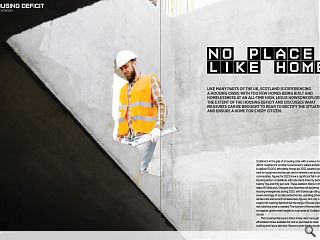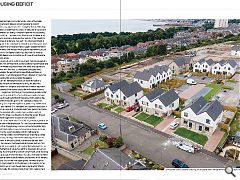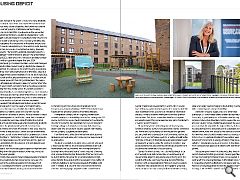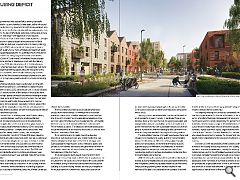Housing Deficit: No Place Like Home
7 May 2024
Like many parts of the UK, Scotland is experiencing a housing crisis with too few homes being built and homelessness at an all-time high. Leslie Howson explores the extent of the housing deficit and discusses what measures can be brought to bear to rectify the situation and ensure a home for every citizen.
Scotland is in the grip of a housing crisis with a serious housing deficit. Despite the Scottish Government’s stated ambition to deliver 110,000 affordable homes by 2032, seventy per cent for social rent and ten per cent in remote rural and island communities, figures for 2023 show a significant fall in all housing sector completions with site starts down by between twenty-five and fifty per cent. These statistics follow in the wake of Edinburgh, Glasgow and Aberdeen all declaring housing emergencies during 2023, with Edinburgh citing a severe shortage of socially rented homes, spiralling private rental costs and record homelessness figures. Not only is supply not meeting demand but the range of house types is not matching what is needed. The number of homes being built set against government targets in rural areas of Scotland is also dismal.
The fundamental issue is there simply aren’t enough affordable homes available for rent or purchase to meet existing and future demand. Reasons given for the housing shortages are high construction costs, a lack of available building land and delays in securing planning consent. However, many organisations including the National Housing Federation consider that this crisis is mostly due to successive governments not having a long-term plan for house building.
Jane Wood, chief executive of Homes for Scotland, which represents members delivering the majority of the country’s new homes of all tenures, has said: “The downward trend in housing starts has now been sustained across three years and evidences the growing challenge to supply suitable homes for those in need. With today’s housing starts representing future completions, the figures starkly illustrate that the housing inequality being experienced across the country will become even more acute. “In practical terms, a planning system that encourages and facilitates new development, so that Scotland has the range and choice of homes required to meet the needs and aspirations of all those who live here, is a fundamental requirement. Unfortunately, the recently introduced National Planning Framework 4 is working against this as is the lack of resources and underinvestment in our planning regime.
“Given the interdependencies between the delivery of private for sale and affordable housing, we also need policymakers to recognise and adopt an all-tenure approach. In the context of the severe cuts to the Affordable Housing Supply Programme that have just been passed, private-sector investment is essential if the Scottish Government is to have a chance of meeting its 110,000 target by 2032. Additionally, consideration must be given to the cumulative impact of upcoming and proposed regulations, particularly in relation to the net zero agenda. Our members fully support the process of transition as soon as is practicable but many questions remain about the required skills, supply chain readiness and grid capacity. The impact on housing must be the golden thread that runs through every decision and directorate.”
Adult home ownership in Scotland is generally agreed to be fifty per cent of the population. For most younger people below the age of 25, trying to buy a home is almost impossible, high rents limit their ability to save to buy a home, hence most are either in rental accommodation or living with parents. Whilst the Scottish Government does at last have a long-term housing strategy it has taken a housing deficit of crisis proportions to bring this about. It remains to be seen how quickly the causes of homelessness and issues such as child poverty, still unacceptably high, can be eliminated and it is not clear whether this strategy has set firm timescales for such an outcome.
According to the Scottish Government, social housing makes up a quarter of all homes in Scotland with large numbers of rentable properties badly needed and at rents which tenants can afford. Short-term rent capping was introduced by the Scottish Government in 2023 with rents in the private sector capped at three per cent though this is due to end in March 2024. Ironically, the consequences of such rent capping have not always worked in the tenant`s favour and many landlords unable to absorb such restrictions have been forced to leave the private rental sector altogether, thus further reducing the already dwindling supply of affordable rented housing. On the 1st of April 2024, the situation will be somewhat reversed with landlords in a position to charge higher rents once again but is also likely to increase the number of evictions of those unable to afford high rents increasing homelessness as a consequence. It is notable that in the public sector, many Scottish councils are proposing to raise rents on social housing, to cover their rising costs, thus further burdening financially taxed tenants.
The Scottish Landlords Association reports a likely eighteen-month transitional phase in the rental market post-April 2024, after which rent restrictions are likely to return though with an upper limit higher than pre-2024. Social housing in Scotland provided, owned and managed by local authorities (council housing ) tends to be cheaper to rent than from the various not-for-profit Housing Associations but both set their rents at either social or affordable rates as a percentage of the local rent markets. From the 1st of April 2024, both councils and housing associations are to increase annual rents to keep pace with their rising cost burdens. The supply of new affordable social housing relies on investment from the Scottish Government, complemented by housing associations borrowing from the private sector.
The current reduction in government funding is not only forcing both sectors to increase annual rents but also having a detrimental effect on their ability to provide the range of schemes they offer to their tenants to buy their properties and get onto the housing ladder. It is evident that introducing restrictions on rent increases in the private sector over the years whilst welcomed by tenants and homelessness charities, has failed to address the underlying problems and in the long term has not benefited either landlords or tenants. What is needed is robust sustainable legislation to rectify the chronic lack of supply of privately rented homes in key areas of Scotland and which controls rents at affordable levels whilst incentivising landlords to remain in the private rental sector. At the same time, councils need to seek more efficiencies in their social housing programmes to reduce costs. It should also be remembered that too few council houses were built to compensate for those lost to Scotland`s `Right to Buy ‘ scheme, albeit that ceased in 2016. For many people, securing a home is akin to a game of snakes and ladders with the direction of travel depending on the throw of the dice. Those on low income struggle to cope with high rents and risk sliding down the system unable to even reach let alone climb the housing ladder. Currently, there are too many homeless people in Scotland and many would say too few resources are being put into ensuring that the existing population has the security of a home.
According to Homes for Scotland, new figures in 2023 show that Scotland’s housing crisis for the homeless is intensifying with more than 39,000 applications for homelessness assistance between 2022-23. Included in these figures are the growing numbers of homeless refugees. Immigration is likely to be an- ongoing problem albeit denied by many as a contributing factor in the housing crisis. Of course, Scotland has always had immigration from outside the UK which the country has benefitted from but any long-term housing strategy in Scotland should ensure that all existing citizens and new arrivals have housing support, with realistic, fair and properly budgeted policies in place. Insufficient and unaffordable homes have also become a serious issue in rural areas which some say are a key cause of de-population. Scotland`s relatively rich capital city should not have such a housing crisis when so much housing continues to be built in and around the city.
However, with no long-term plan for building the numbers and type of homes required, a housing crisis was inevitable. Notably, thousands of homes continue to be built in Edinburgh, either for university students or high-priced flats for those able to afford expensive homes neither of which are available to low-income groups at affordable rents, even if rentable at all. Student flats funded and of benefit to overseas non-tax paying companies make up more than a quarter of approved developments in Edinburgh. In several areas of the city, permission was granted for more student flats than residential homes, according to freedom of information statistics. In many locations where permission was given for most student flats, local communities have for some years expressed concern that some areas are now being flooded with university accommodation.
None of these forms of housing are suitable for young families in what has surely for decades been a family-orientated city. Within the city boundary, too few houses with gardens are being built and no terraced or small semi-detached houses which is what young families need. It is a matter of building the right type of housing in the right place and appropriate to each demographic group in society. By contrast in London, many social and family housing schemes are being built as the norm to address the current lack of social housing. Surely, the potential exists for a city like Edinburgh to be enriched with close-knit communities of social housing. At the same time, large housing estates are springing up on the outskirts of the city, commuter housing, devoid of facilities and much of it on green belt land. Most such housing consists of detached villas dedicated to one demographic group but devoid of any on-site community facilities for families to enjoy.
Here what surely needs to happen is the building of settlements with community and commercial facilities. Aberdeen`s housing supply crisis is no better than Edinburgh`s. The homeless charity Shelter has reported that the supply of good quality and affordable social housing remains inadequate in Aberdeen, forcing people into expensive and poor-quality homes. Shelter has advocated the use of empty and vacant properties throughout the city, that new housing developments should be part of sustainable and vibrant communities with access to vital services and that further investment should be made in existing housing stock to bring it up to a suitable standard of long-lasting repair including improvements to energy efficiency. They have also called for more temporary accommodation in Aberdeen and a more caring and fair approach to dealing with homelessness in general. Successive government initiatives including those of the current devolved Scottish government, have largely failed to meet the housing shortfall and have not succeeded in dealing with the ongoing shortage of affordable homes. This is irrespective of which political party is in power and housing has been an ongoing political football for decades. High-rise housing of the late 1950`s and 60`s in Scotland under a UK labour government was a social failure proving especially unsuitable for housing families. In later years, selling off council houses under the Tory government’s right-to-buy initiative, as a vote catcher, proved to be a mistake with no replacements, thus adding to the lack of affordable rented council housing. A more intelligent and longer-term approach is now required.
The Scottish Government still has several policies, strategies and initiatives in place to ease the housing crisis. In March 2021, Scotland’s first ever long-term national housing strategy `Housing to 2040`, set out a vision for everyone to have a safe, high-quality home that is affordable to meet their needs including getting people into the estimated 43,000 thousand empty homes and being tough on second home owners. The Scottish Government’s Affordable Housing Supply Programme reached a milestone in 2023 with the delivery of more than 500 affordable homes. For first-time buyers, several schemes have been set up in the recent past but many have closed thus limiting opportunities for this sector of the population. However, there are still shared equity schemes available to first-time buyers to purchase a home on the open market or to buy a newly built home from a council or housing association. The Rural and Islands housing action plan is in line with the Scottish Government’s commitment to deliver 110,000 affordable homes by 2032, with ten per cent in rural and island regions. It sets out action so that people in these areas have access to high-quality affordable and market housing to enable them to live, work and thrive in their home area.
The plan aims to deter second and holiday home ownership to improve affordability for local people, especially in remote areas of the country, with local people coming first and ensuring that in rural areas, there is a balance between the economic benefits of tourism and housing needs. It is evident that to achieve government house-building targets several changes need to be made and barriers removed. The planning system needs to be simplified to speed up applications, it is too slow and complex at present.
The Competitions and Markets Authority (CMA) described the planning system as: “Complex and unpredictable with planning often taking builders a long time to navigate before construction can start.” It found that many planning departments are under-resourced, don’t have up-to-date local plans and lack clear targets or incentives to deliver a certain number of homes in their area. Builders also often have to consult with a wide range of people and slow responses to planning proposals can delay construction. The CMA said that streamlining the planning system would mean more homes could be built each year and help ‘make homes more affordable’. The lack of development land and over-protection of the green belt is often cited as one barrier to the building of more houses. However, more consideration to building at greater densities, including on brownfield sites, would make better use of land that is available. There is a need for joined-up social policies which build bridges from homelessness, to owning a home or at least enjoying a stable rental situation, along with innovative ideas and long-term programmes to eradicate homelessness.
One such non-governmental example in England is the Homewards Initiative scheme run from Centre Point in London and with Prince William as patron. The initiative is aimed at testing ideas to cut homelessness at six locations across the UK over the next five years, including in Aberdeen. The programme aims to create innovative housing projects at each location, to set up a flexible model that can then be adopted in other areas of the UK in the longer term. Such approaches require party politics free plans; public and private sector, charities businesses and government to work in close collaboration and all committed to the goal of reducing homelessness in the short term. The housing sector badly needs investment from both government and private sources.
Profits from the private sector should benefit the public sector more than is the case currently for example taxing offshore companies behind the excessive building of student housing. Houses are simply too expensive for most prospective homeowners, especially those on low incomes and the young, trying to get on the property ladder. Construction costs will also have to be reduced to bring down house prices. Housing policies are required which embrace the needs of all demographic groups in society, in particular those on low incomes, those at the poverty level, the ageing population and young families and put sustainable mechanisms in place at a governmental level which are sustainable irrespective of which party is in power and with new strategies that can work in the short and long term and with clear regional housing policies.
The immediate challenge is to build more houses faster and cheaper while maintaining quality. Building more affordable homes should not be so difficult to achieve given the right political will and policies, the right kind of financial support, a greater degree of innovation, the availability of sufficient building land and using more prefabrication and off-site construction methods; perhaps also building smaller and thus more affordable starter homes. Whilst boosting the number of homes built is critical, place-making, building neighbourhoods and sustainable settlements with integrated community facilities should not be overlooked. Simply building sprawling often soulless estates of vast numbers of houses is not sustainable nor desirable; they tend to lack identity or a sense of belonging and well-being which residents need to form a community.
The ongoing housing crisis should be containable. Much new housing provision in Scotland is in the hands of the private sector, a handful of building companies and land owners, incentivised by profit. Albeit obligated by the government to include a minimum percentage of affordable homes, their customers are mostly those who can afford their usually standard, high-priced house types, targeted at the more comfortably off sectors of society. However, it is not they who should be expected to manage the government housing targets nor be responsible for the provision of sufficient social housing. Ultimately it is the responsibility of the Scottish government to reduce the housing deficit, keep ahead of the housing problems to resolve homelessness, simplify the planning system and ensure that the affordable housing proportion is provided, instigate the building of enough social housing to meet demand, see that houses are provided in the right places and of the right type, ensure that all sectors of society are provided for, in particular those on low or no incomes and above all to ensure that everyone in Scotland has the opportunity to have a home of their own.
|
|






